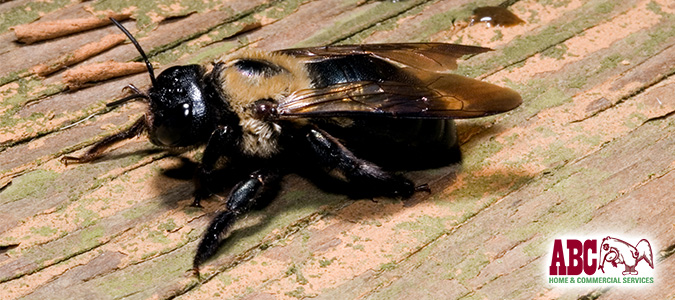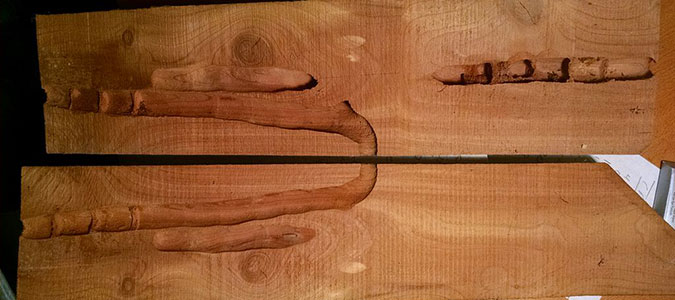Bees, bugs and butterflies are emerging from their winter nests seeking food and new shelter. Spring is in the air… literally.
When most of us think of bees, we think of honeybees, which are the social and mostly-beneficial insects we love and make movies about. But, there are other bee species out there and they are not all as friendly and helpful.
Carpenter bees, for instance, can cause serious structural damage and staining. While carpenter bees don’t eat wood, they burrow narrow tunnels to create chambers for rearing their offspring.
Carpenter Bees
Carpenter bees get their name from their biological ability to drill through wood. When spring comes around, female carpenter bees start to chew into dry wood, normally logs and lumber. Instead of biting into the wood for food, female carpenter bees are actually forming narrow canals for the purposes of laying eggs.
Known as galleries, these small tunnels are around 4-6 inches deep and contain 6 cells. The mother bee provides a single egg, pollen and nectar for each cell. This combination is sometimes call “bee bread.”
When the eggs hatch, the larvae develops within the cell until it is safe to exit the gallery. Carpenter bees normally exit the gallery in late summer or spring. In order to survive the winter weather, carpenter bees will stay in their galleries until spring.
Why Carpenter Bees Are a Problem
One carpenter bee isn’t a problem, but multiple bees over multiple years can cause considerable damage to wood structures and homes.
Carpenters bees are most attracted to untreated wood. Unpainted areas, such as doors, windows, eaves, railings, telephone poles, decks and even deck furniture are vulnerable to attack.
The female bee drills a near-perfect hole around ½” in diameter. She then takes a hard 90-degree turn in the direction of the grain and starts drilling a tunnel (called a “gallery”) in which to rear her young.
Eventually, the wood-drilling activities of female bees will cause irreversible structural damage with costly implications.
If you notice carpenter bees buzzing or distinctive holes in your woodwork, act fast!
For professional bee removal, contact ABC Home & Commercial Services.
How to Identify Carpenter Bees
 Carpenter bees resemble bumble bees, but you can tell them apart by their abdomens. Bumble bees are rounder and hairier, while carpenter bees have a black, metallic-looking abdomen.
Carpenter bees resemble bumble bees, but you can tell them apart by their abdomens. Bumble bees are rounder and hairier, while carpenter bees have a black, metallic-looking abdomen.
While bumblebees nest underground, carpenter bees build their nests in trees and wood structures, such as your house and deck. In addition to color and appearance, you can tell if you have carpenter bees if you see them hovering near eaves and soffits or drilling into wood.
Male carpenter bees are the most conspicuous since the hang around their nest and dart at any flying insect that comes close. They are also known to hover around people if they make fast and sudden movements. Although the males can cause terror and panic, they are unable to sting you.
Only females can sting, but they rarely do. You would have to go out of your way to provoke a female carpenter bee into stinging you.
How to Identify Carpenter Bee Galleries
Gallery openings are around ½-inch in diameter and are pretty noticeable and easy to identify. If you see any wood that is riddled with holes, you probably have carpenter bees.
Holes in your home’s wood are not only unsightly, they can also encourage other pests to take advantage of these openings as well.
How to Prevent Carpenter Bees
There are several things you can do to prevent carpenter bees from coming back this spring:
1. Paint/Varnish
Since carpenter bees rarely choose to excavate galleries in painted or varnished wood, this is the main prevention method used by homeowners.
Use a sealing primer and a minimum of 2 coats of paint on all of your wood surfaces for the greatest protection. Stains and varnishes are better than nothing, but ideally you want primer and paint.
2. Treated Wood/Hardwoods
Carpenter bees prefer untreated, softwoods. While they may still burrow through treated woods and hardwoods, it’s much better than bare, softwoods.
3. Change Materials
If the carpenter bees are relentless, you may want to consider non-wood options, such as vinyl, cement and masonry.
4. Seal Holes and Cracks Before Painting
Before applying any paint, primer or wood treatments, make sure you fill or seal all of the cracks, holes and splintered wood first. These areas make an easy and attractive starting point for bees.
How to Get Rid of Existing Carpenter Bees
Don’t allow your home or business to become a target for carpenter bees!
While these flying insects don’t pose a significant threat to people, they will destroy your wood structures and attack humans if they feel under attack.
If you notice any evidence of carpenter bees on your property, such as holes in wood around the home, don’t hesitate to contact ABC Home & Commercial Services.
Our Pest Management Professional will help identify the source of your bee problem and determine the safest and most effective treatment for dealing with these wood-destroying insects.
Do not use any pesticides without consulting a pest professional first. Before you start swatting and spraying, contact ABC Home & Commercial Services for professional bee removal.

